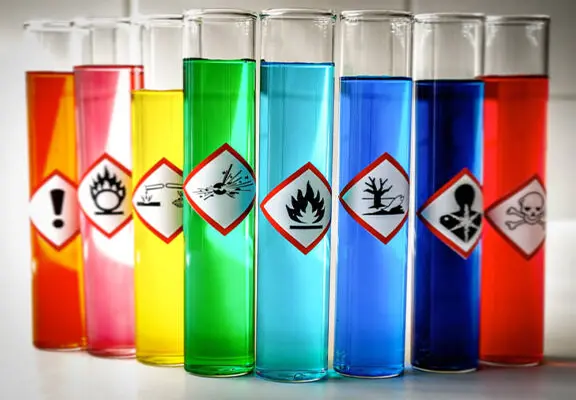The Classification, Labelling and Packaging (CLP) Regulation is the European Union regulation defining the rules that must be respected for hazardous products in Europe, whether they are industrial products or those made available to the public. This regulation uses the classification of the UN Globally Harmonized System.
Recently, the European Union has updated this regulation to include classifications for substances with the following properties:
- Endocrine disruptors
- Persistent, bioaccumulative and toxic substances
- Persistent, mobile and toxic substances
Let's see the impacts of this new regulation.
Endocrine disruptors
Endocrine disruptors are substances that alter one or more functions of the endocrine system and thus induce adverse effects on health, offspring or populations or subpopulations.
The endocrine system is the set of organs that have the capacity to secrete hormones and release them into the blood. These hormones can play several roles in the body, such as:
- Control growth
- Control development
- Help with sleep or wakefulness
The criteria for classifying a substance as an endocrine disruptor were adopted by the European Union by Regulation 2018/605, which established these criteria. Essentially, the regulation defined endocrine disruptors as substances with three (3) criteria:
- The substance must cause an adverse effect in an organism or its descendants
- The substance must have an endocrine mode of action
- The adverse effect must be a consequence of the endocrine mode of action
In other words, endocrine disruptors are substances that, through their presence in an organism, affect the hormonal system. For example, we can think of a substance that interferes with the production of a growth hormone, which prevents an individual from growing normally, or a molecule that acts as a wakefulness hormone, preventing the individual from falling asleep.
Types of endocrine disruptors
Without going into detail, the regulations present two different types of endocrine disruptors, namely disruptors for human health and disruptors for the environment. These two classifications are not mutually exclusive.
In both cases, there are two categories of hazard: one for known or presumed endocrine disrupting activity, and one for suspected activity. This gives rise to 4 new EUH hazard phrases:
- EUH380: May cause endocrine disruption in humans
- EUH381: Suspected of causing endocrine disruption in humans
- EUH430: May cause endocrine disruption in the environment
- EUH431: Suspected of causing endocrine disruption in the environment
Classification of endocrine disruptors
In the case of substances, classification as endocrine disruptors is complex. The classification criteria are based on the available data, the weight of evidence and expert judgement, taking into account both positive and negative studies.
In the case of mixtures, classification thresholds have been established based on the concentrations of substances classified as endocrine disruptors. In the case of category 1 endocrine disruptors, i.e. those that are known or presumed, the classification threshold is 0.1%. In the case of category 2 endocrine disruptors, i.e. those that are suspected, the threshold is set at 1%. These thresholds are the same for endocrine disruptors affecting human health and for those affecting the environment.
As is generally the case in the GHS, the classification of the mixture by the concentration thresholds is valid, but experimental data would take precedence for the classification.
Finally, note that, although the classification of the mixture as an endocrine disruptor for category 2 is done from 1%, a safety data sheet is required from 0.1%.
Persistent, bioaccumulative and toxic substances
Substances that combine the properties of persistent, bioaccumulative and toxic (PBT) are classified in this new category. To understand them, it is necessary to define each of the terms used in the regulation.
Persistence
Persistence is the property of a substance to last over time. This property is evaluated based on the half-life of the substance, which is the time required for half of the substance to be degraded by microorganisms.
Depending on the time it takes for a substance to degrade er during testing, the substance can be considered persistent (P) or very persistent (vP). The following table presents the different thresholds that, when exceeded, lead to the classification of persistence:
| Medium |
Half-life time to be persistent (days) |
Half-life time to be very persistent (days) |
| Sea water |
60 |
60 |
| Fresh or estuarine water |
40 |
60 |
| Marine sediments |
180 |
180 |
| Fresh or estuarine sediments |
120 |
180 |
| Soil |
120 |
180 |
Exceeding only one of the thresholds in the table is sufficient to classify the substance as persistent or very persistent.
Bioaccumulation
Bioaccumulation is the phenomenon by which the concentration of a substance gradually increases over time in a species. Under the Regulation, a substance is considered bioaccumulative if its bioconcentration factor in aquatic species is greater than 2000. Similarly, if this factor is greater than 5000, the substance is considered very bioaccumulative.
The bioaccumulation factor is measured by a ratio between the concentration of a substance in water and the concentration of the same substance in the aquatic organism. A substance meeting the bioaccumulation criterion would therefore be present in a concentration at least 2000 times greater in aquatic organisms than in their immediate environment.
Toxicity
Under the current framework, the Regulation defines as "toxic”, or meeting the T criterion for PBT, substances that meet at least one of the following criteria:
- The long-term no-observed-effect concentration or EC10 value (e.g. EC10) for marine or freshwater organisms is less than 0.01 mg/L
- The substance is already classified in one of the following hazard categories:
- Carcinogenic (category 1A or 1B)
- Germ cell mutagenic (category 1A or 1B)
- Toxic for reproduction (Category 1A, 1B or 2)
- Toxic to specific target organs through repeated exposure (Category 1 or 2)
- Endocrine disruptor for human health (Category 1 or 2)
- Endocrine disruptor for the environment (Category 1 or 2)
Product classification
When the properties of persistence, biodegradability and toxicity have been established, it is possible to determine the classification of this substance as PBT or vPvB.
If a substance meets the criteria to be classified as very persistent (vP) and very bioaccumulative (vb), it is immediately classified as vPvB. Substances classified as vPvB must be identified by the following new hazard phrase:
- EUH441: Strongly accumulates in the environment and in living organisms including in humans
If a substance meets the criteria for persistence, biodegradability and toxicity, it is classified as PBT. Substances classified as PBT must be identified by the following new hazard phrase:
- EUH440: Accumulates in the environment and in living organisms including in humans
Mixtures that contain a substance classified as PBT or vPvB at a concentration of 0.1% or more are also classified in this category.
Persistent, mobile and toxic substances
Another category added by the regulatory review is that of persistent, mobile and toxic substances (PMT). These substances have been declared of particular interest because of their mobility, which gives them the possibility of infiltrating deeply into the soil and contaminating water resources in the long run.
The classification of substances in this category depends on the three properties. Since persistence and toxicity have already been defined in the last section, mobility remains to be defined.
Mobility
The mobility of a substance can be defined as its property of infiltrating deeply into the soil. This property is measured by the parameter log Koc, i.e. the logarithm of the organic carbon/water partition coefficient. The higher this value, the more a substance will tend to adsorb strongly to the soil and will therefore have less tendency to infiltrate deeply. Conversely, the lower this parameter, the less the substance will be retained by the soil, and it will therefore be able to infiltrate more deeply.
A substance is defined as "Mobile” in this Regulation if its log Koc parameter is less than 3. Similarly, a substance is defined as "Very Mobile” if its log Koc parameter is less than 2. In cases where we are talking about an ionisable substance, the parameter to be assessed is the lowest in a pH range between 4 and 9.
Product classification
As soon as a substance meets the criteria to be classified as "Very Persistent” and "Very Mobile”, it is immediately classified as such in the vPvM category. The following hazard phrase must then be indicated on the product:
- EUH451: Can cause very long-lasting and diffuse contamination of water resources
Similarly, if a substance meets the criteria of persistence, mobility and toxicity, it must be classified in the PMT category, and the following hazard phrase is associated with it:
- EUH450: Can cause long-lasting and diffuse contamination of water resources
In the case of mixtures, the classification threshold is set at 0.1%. If a mixture contains 0.1% or more of a substance classified as PMT or vPvM, the mixture must also be classified in this category.
Transition period
These changes are a significant modification to European regulations, and consequently a transition period has been planned to allow companies to adjust. The regulation provides that substances will have to be classified according to the new categories from May 1st, 2025. However, substances placed on the market before this date will benefit from an exemption until November 1st, 2026.
For mixtures that would be affected by the new regulation, the new classification will have to be in place from May 1st, 2026, but mixtures placed on the market before this date will benefit from an exemption until May 1st, 2028.
Pour ce qui est des mélanges qui seraient affectés par la nouvelle réglementation, la nouvelle classification devra être en place à partir du 1er mai 2026, mais les mélanges mis en marché avant cette date bénéficieront d'une exemption jusqu'au 1er mai 2028.
Conclusion
With this regulatory update, the European Union is once again tightening the rules for hazardous products. This is in line with the European Union's vision to protect human, animal and environmental health, these being intrinsically linked.
However, these new updates further complicate the penetration of the European market. For this reason, calling on experts is practically essential. If you need help preparing the sale of your products in Europe, Kalium Solutions' experts can help you. Do not hesitate to contact us for more information!





